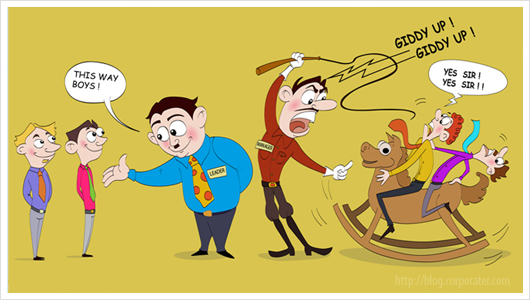
Every organisation has different types of individuals, but out of those the bosses come in different flavors. Of course you have your typical manager that enjoys bossing you around and then you have your leaders the kind that works with you and directs you to grow with every experience. If you have been working for a while now surely you have met your fair share of bosses. And if you are still new to the professional world, well, there’s a long line of bosses just waiting to meet you. Some of them you will love, some would be more of an acquired taste and some you’d simply hate. If you are still not sure of what these different flavor might be, well they are typically your leaders and managers. And no, they are not the same and yes, they have a whole lot of differences between them. Here’s a comparison of Leaders vs. Managers.
Team vs subordinates

Although this is not a term that we pay that much attention to, this makes a difference when it comes to your superiors because this sets apart the leaders apart from managers. A leader will always treat his/her staff as team members, treating them at a more friendly level. Although a manager takes pride in that title and he/she will treat the staff as individuals under his/her power. A leader takes time to get to know his team and often have casual chats with the employees and genuinely care about their wellbeing. A manager on the other hand is more interested in the work that needs to be completed and less attention goes into getting to know the employee. The biggest difference is that a leader would back his team up through good and bad and the team will stand by him/her through anything. But a manger would take credit for the work that his/her employees did and put the blame on them when things don’t go right.
Request vs order

Every superior has a style that they use to make a request. A leader would always make a request from the team after having a discussion with them on their work load and available dates. Although things will not go the same way when it comes to a manager because when he/she gives an order it set on stone, the employee have to complete that task by the deadline regardless of how much work they have. This is not a kind request, it’s a command. A leader has a team that wants to work with him but a manager on the other hand has a group of individuals that fear his orders. When the work takes longer than expected an employee is able to have a conversation with the leader to extend the discussed dates, but a manager might not be very happy with that.
Team vs subordinates

We all have had a fair share of uncomfortable conversations with our superiors. It’s not always the content that might make you uncomfortable, often times it is the tone or the words that they chose to use to describe it. A leader would gather his/her team and have a friendly discussion with them. Where they are given the chance to respond and comment on the content of the discussion. Although a manager will usually talk at the employees, while they listen in an awkward silence. There’s a difference between “Talking at” and “Talking with” and that is the difference that sets apart a manager from a leader. The team is comfortable around a leader although employees might not feel or want to show that they are comfortable with a manager.
Follow up vs reminder

When it comes to any work regardless of how big or small it is, a superior always keeps an eye on its progress. And the difference between a leader and manager checking up would be that a leader always follows up through every step up the way, questioning on the progress and offering help to complete it effectively. A manager would send a reminder on when it needs to be submitted. When a leader is guiding and supporting the team with the tasks that they are assigned to complete it gives them a level of confidence to work harder on it. A reminder on the other hand activates that internal clock that warns the employees when the bomb is about to go off. Putting that extra pressure that makes things even harder. A leader takes away that pressure and reminds that he/she is there to support the team push through tough times.
Job well done vs a pat on the back>

There are always some tasks that put us through hell and back just to complete it successfully. And when it is all done and everyone is happy with it, we all would like a word of appreciation that takes that extra effort to the next level. No one does the work expecting it but it does put the cherry on top of the cake. How a leader and a manager handles it is again different from each other. A leader will make sure the relevant parties know who was responsible in getting the work done and he/she would probably give a treat to the team encouraging them to keep doing the same. The team might even be considered for increments or even bonuses based on their contribution. A manager on the other hand would take the credit to him/her-self and give you a smile and a pat on the back. It leaves an incomplete feeling that lingers even though the work is done.
Although the differences look simple on paper when it comes to reality the impact it makes is much greater. While the leader takes the team on a journey a manger keeps the subordinates going in circles. And in the long run a leader will always have a team following his footsteps and thriving to become better and stronger together. At the end they will all be leaders in the making. Every employee is looking for mentor and not dictator, someone that can guide them to one day be a leader themselves. A superior role in an organisation should always be a leader to his/her team because no one will remember a character that made a negative impact, but a great person with values will always be spoken of.







